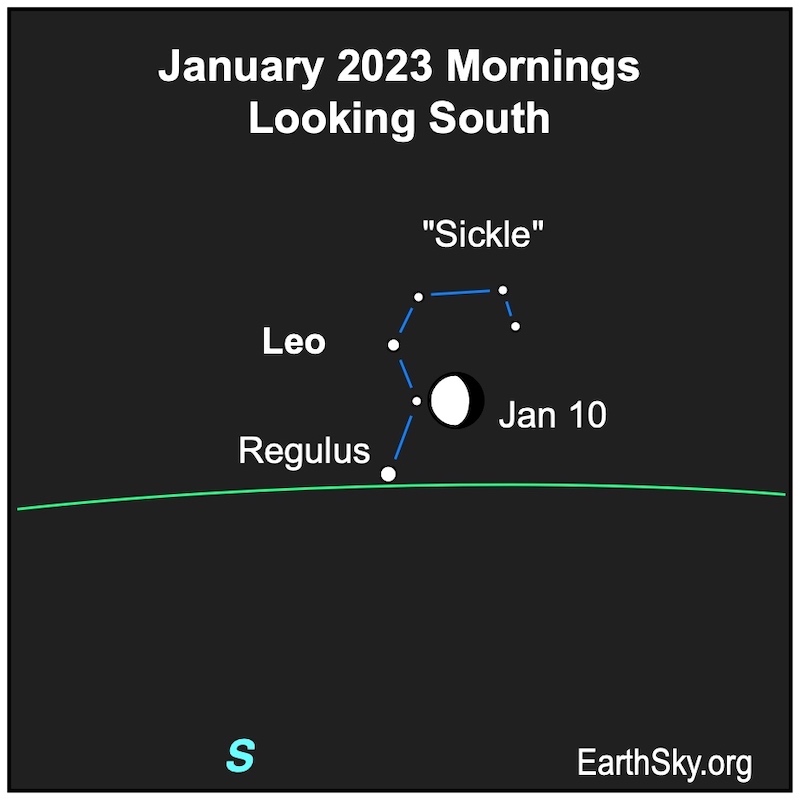
Moon near the Sickle of Leo
Late at night on January 9, 2023 – and early in the morning on January 10 – you’ll find the waning gibbous moon glowing in the direction of the Sickle of Leo the Lion. The moon’s bright, glowing presence will make it harder to spot the dimmer Sickle stars. So start by looking for Regulus, Leo’s brightest star, which should be visible shining in the moon’s glare.
Note that the Sickle has a distinctive shape, that of a backwards question mark. And Regulus marks the period at the bottom of the backward question mark pattern.
In fact, Regulus is the only 1st-magnitude star that sits almost right on the ecliptic, the path the sun follows through the sky. So Regulus is often near a bright planet and can even be occulted (covered over) by the moon.
The moon will be right beside the next star up on the Sickle, dim Eta Leonis. But the star that marks the lower curve of the Sickle is magnitude 2.1 Algieba. Can you make it out and then trace the rest of the Sickle’s shape?
The view from the Southern Hemisphere
If you’re south of the equator, the Sickle looks like an upside down and backward question mark. As you can see, depending on your location on Earth, the view of the night sky changes slightly. So, if you’re in the Southern Hemisphere, turn our maps upside down for a more accurate view. Or try Stellarium for a precise star chart from your location.
Bottom line: You can spot the waning gibbous moon near the Sickle of Leo the Lion and its brightest star, Regulus, on the morning of January 10, 2023.
For more great observing events in the coming weeks, visit EarthSky’s night sky guide
The post Moon near the Sickle of Leo, January 10 first appeared on EarthSky.
from EarthSky https://ift.tt/TpE0qKJ

Moon near the Sickle of Leo
Late at night on January 9, 2023 – and early in the morning on January 10 – you’ll find the waning gibbous moon glowing in the direction of the Sickle of Leo the Lion. The moon’s bright, glowing presence will make it harder to spot the dimmer Sickle stars. So start by looking for Regulus, Leo’s brightest star, which should be visible shining in the moon’s glare.
Note that the Sickle has a distinctive shape, that of a backwards question mark. And Regulus marks the period at the bottom of the backward question mark pattern.
In fact, Regulus is the only 1st-magnitude star that sits almost right on the ecliptic, the path the sun follows through the sky. So Regulus is often near a bright planet and can even be occulted (covered over) by the moon.
The moon will be right beside the next star up on the Sickle, dim Eta Leonis. But the star that marks the lower curve of the Sickle is magnitude 2.1 Algieba. Can you make it out and then trace the rest of the Sickle’s shape?
The view from the Southern Hemisphere
If you’re south of the equator, the Sickle looks like an upside down and backward question mark. As you can see, depending on your location on Earth, the view of the night sky changes slightly. So, if you’re in the Southern Hemisphere, turn our maps upside down for a more accurate view. Or try Stellarium for a precise star chart from your location.
Bottom line: You can spot the waning gibbous moon near the Sickle of Leo the Lion and its brightest star, Regulus, on the morning of January 10, 2023.
For more great observing events in the coming weeks, visit EarthSky’s night sky guide
The post Moon near the Sickle of Leo, January 10 first appeared on EarthSky.
from EarthSky https://ift.tt/TpE0qKJ

Aucun commentaire:
Enregistrer un commentaire